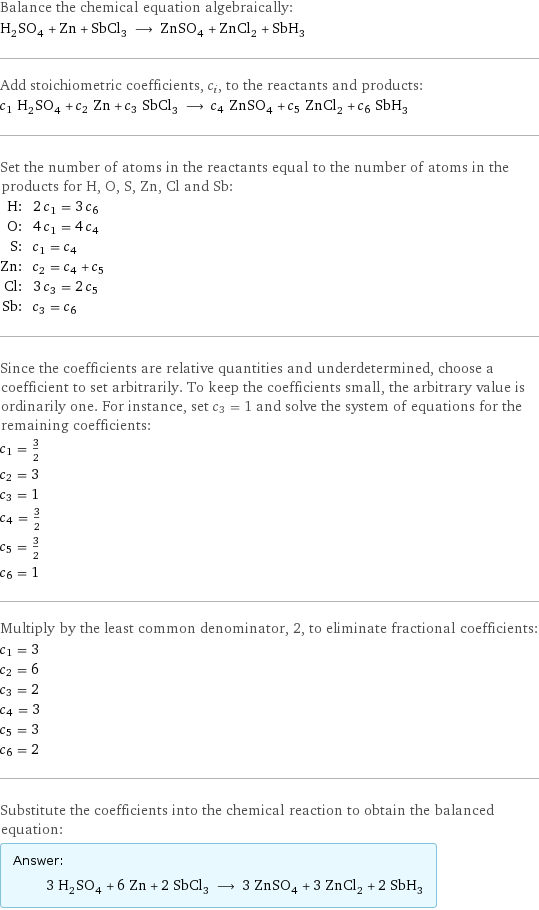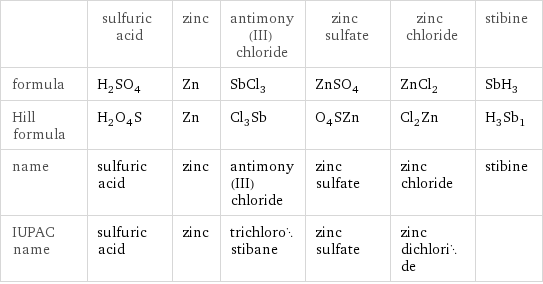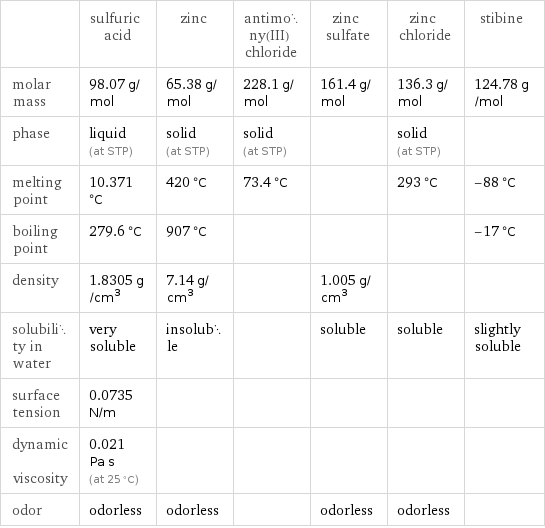Input interpretation

H_2SO_4 sulfuric acid + Zn zinc + SbCl_3 antimony(III) chloride ⟶ ZnSO_4 zinc sulfate + ZnCl_2 zinc chloride + SbH_3 stibine
Balanced equation

Balance the chemical equation algebraically: H_2SO_4 + Zn + SbCl_3 ⟶ ZnSO_4 + ZnCl_2 + SbH_3 Add stoichiometric coefficients, c_i, to the reactants and products: c_1 H_2SO_4 + c_2 Zn + c_3 SbCl_3 ⟶ c_4 ZnSO_4 + c_5 ZnCl_2 + c_6 SbH_3 Set the number of atoms in the reactants equal to the number of atoms in the products for H, O, S, Zn, Cl and Sb: H: | 2 c_1 = 3 c_6 O: | 4 c_1 = 4 c_4 S: | c_1 = c_4 Zn: | c_2 = c_4 + c_5 Cl: | 3 c_3 = 2 c_5 Sb: | c_3 = c_6 Since the coefficients are relative quantities and underdetermined, choose a coefficient to set arbitrarily. To keep the coefficients small, the arbitrary value is ordinarily one. For instance, set c_3 = 1 and solve the system of equations for the remaining coefficients: c_1 = 3/2 c_2 = 3 c_3 = 1 c_4 = 3/2 c_5 = 3/2 c_6 = 1 Multiply by the least common denominator, 2, to eliminate fractional coefficients: c_1 = 3 c_2 = 6 c_3 = 2 c_4 = 3 c_5 = 3 c_6 = 2 Substitute the coefficients into the chemical reaction to obtain the balanced equation: Answer: | | 3 H_2SO_4 + 6 Zn + 2 SbCl_3 ⟶ 3 ZnSO_4 + 3 ZnCl_2 + 2 SbH_3
Structures

+ + ⟶ + +
Names

sulfuric acid + zinc + antimony(III) chloride ⟶ zinc sulfate + zinc chloride + stibine
Equilibrium constant
![Construct the equilibrium constant, K, expression for: H_2SO_4 + Zn + SbCl_3 ⟶ ZnSO_4 + ZnCl_2 + SbH_3 Plan: • Balance the chemical equation. • Determine the stoichiometric numbers. • Assemble the activity expression for each chemical species. • Use the activity expressions to build the equilibrium constant expression. Write the balanced chemical equation: 3 H_2SO_4 + 6 Zn + 2 SbCl_3 ⟶ 3 ZnSO_4 + 3 ZnCl_2 + 2 SbH_3 Assign stoichiometric numbers, ν_i, using the stoichiometric coefficients, c_i, from the balanced chemical equation in the following manner: ν_i = -c_i for reactants and ν_i = c_i for products: chemical species | c_i | ν_i H_2SO_4 | 3 | -3 Zn | 6 | -6 SbCl_3 | 2 | -2 ZnSO_4 | 3 | 3 ZnCl_2 | 3 | 3 SbH_3 | 2 | 2 Assemble the activity expressions accounting for the state of matter and ν_i: chemical species | c_i | ν_i | activity expression H_2SO_4 | 3 | -3 | ([H2SO4])^(-3) Zn | 6 | -6 | ([Zn])^(-6) SbCl_3 | 2 | -2 | ([SbCl3])^(-2) ZnSO_4 | 3 | 3 | ([ZnSO4])^3 ZnCl_2 | 3 | 3 | ([ZnCl2])^3 SbH_3 | 2 | 2 | ([SbH3])^2 The equilibrium constant symbol in the concentration basis is: K_c Mulitply the activity expressions to arrive at the K_c expression: Answer: | | K_c = ([H2SO4])^(-3) ([Zn])^(-6) ([SbCl3])^(-2) ([ZnSO4])^3 ([ZnCl2])^3 ([SbH3])^2 = (([ZnSO4])^3 ([ZnCl2])^3 ([SbH3])^2)/(([H2SO4])^3 ([Zn])^6 ([SbCl3])^2)](../image_source/bc288388911b16e844811dede66a4d52.png)
Construct the equilibrium constant, K, expression for: H_2SO_4 + Zn + SbCl_3 ⟶ ZnSO_4 + ZnCl_2 + SbH_3 Plan: • Balance the chemical equation. • Determine the stoichiometric numbers. • Assemble the activity expression for each chemical species. • Use the activity expressions to build the equilibrium constant expression. Write the balanced chemical equation: 3 H_2SO_4 + 6 Zn + 2 SbCl_3 ⟶ 3 ZnSO_4 + 3 ZnCl_2 + 2 SbH_3 Assign stoichiometric numbers, ν_i, using the stoichiometric coefficients, c_i, from the balanced chemical equation in the following manner: ν_i = -c_i for reactants and ν_i = c_i for products: chemical species | c_i | ν_i H_2SO_4 | 3 | -3 Zn | 6 | -6 SbCl_3 | 2 | -2 ZnSO_4 | 3 | 3 ZnCl_2 | 3 | 3 SbH_3 | 2 | 2 Assemble the activity expressions accounting for the state of matter and ν_i: chemical species | c_i | ν_i | activity expression H_2SO_4 | 3 | -3 | ([H2SO4])^(-3) Zn | 6 | -6 | ([Zn])^(-6) SbCl_3 | 2 | -2 | ([SbCl3])^(-2) ZnSO_4 | 3 | 3 | ([ZnSO4])^3 ZnCl_2 | 3 | 3 | ([ZnCl2])^3 SbH_3 | 2 | 2 | ([SbH3])^2 The equilibrium constant symbol in the concentration basis is: K_c Mulitply the activity expressions to arrive at the K_c expression: Answer: | | K_c = ([H2SO4])^(-3) ([Zn])^(-6) ([SbCl3])^(-2) ([ZnSO4])^3 ([ZnCl2])^3 ([SbH3])^2 = (([ZnSO4])^3 ([ZnCl2])^3 ([SbH3])^2)/(([H2SO4])^3 ([Zn])^6 ([SbCl3])^2)
Rate of reaction
![Construct the rate of reaction expression for: H_2SO_4 + Zn + SbCl_3 ⟶ ZnSO_4 + ZnCl_2 + SbH_3 Plan: • Balance the chemical equation. • Determine the stoichiometric numbers. • Assemble the rate term for each chemical species. • Write the rate of reaction expression. Write the balanced chemical equation: 3 H_2SO_4 + 6 Zn + 2 SbCl_3 ⟶ 3 ZnSO_4 + 3 ZnCl_2 + 2 SbH_3 Assign stoichiometric numbers, ν_i, using the stoichiometric coefficients, c_i, from the balanced chemical equation in the following manner: ν_i = -c_i for reactants and ν_i = c_i for products: chemical species | c_i | ν_i H_2SO_4 | 3 | -3 Zn | 6 | -6 SbCl_3 | 2 | -2 ZnSO_4 | 3 | 3 ZnCl_2 | 3 | 3 SbH_3 | 2 | 2 The rate term for each chemical species, B_i, is 1/ν_i(Δ[B_i])/(Δt) where [B_i] is the amount concentration and t is time: chemical species | c_i | ν_i | rate term H_2SO_4 | 3 | -3 | -1/3 (Δ[H2SO4])/(Δt) Zn | 6 | -6 | -1/6 (Δ[Zn])/(Δt) SbCl_3 | 2 | -2 | -1/2 (Δ[SbCl3])/(Δt) ZnSO_4 | 3 | 3 | 1/3 (Δ[ZnSO4])/(Δt) ZnCl_2 | 3 | 3 | 1/3 (Δ[ZnCl2])/(Δt) SbH_3 | 2 | 2 | 1/2 (Δ[SbH3])/(Δt) (for infinitesimal rate of change, replace Δ with d) Set the rate terms equal to each other to arrive at the rate expression: Answer: | | rate = -1/3 (Δ[H2SO4])/(Δt) = -1/6 (Δ[Zn])/(Δt) = -1/2 (Δ[SbCl3])/(Δt) = 1/3 (Δ[ZnSO4])/(Δt) = 1/3 (Δ[ZnCl2])/(Δt) = 1/2 (Δ[SbH3])/(Δt) (assuming constant volume and no accumulation of intermediates or side products)](../image_source/befbdb343af52baf7794ef0df943431f.png)
Construct the rate of reaction expression for: H_2SO_4 + Zn + SbCl_3 ⟶ ZnSO_4 + ZnCl_2 + SbH_3 Plan: • Balance the chemical equation. • Determine the stoichiometric numbers. • Assemble the rate term for each chemical species. • Write the rate of reaction expression. Write the balanced chemical equation: 3 H_2SO_4 + 6 Zn + 2 SbCl_3 ⟶ 3 ZnSO_4 + 3 ZnCl_2 + 2 SbH_3 Assign stoichiometric numbers, ν_i, using the stoichiometric coefficients, c_i, from the balanced chemical equation in the following manner: ν_i = -c_i for reactants and ν_i = c_i for products: chemical species | c_i | ν_i H_2SO_4 | 3 | -3 Zn | 6 | -6 SbCl_3 | 2 | -2 ZnSO_4 | 3 | 3 ZnCl_2 | 3 | 3 SbH_3 | 2 | 2 The rate term for each chemical species, B_i, is 1/ν_i(Δ[B_i])/(Δt) where [B_i] is the amount concentration and t is time: chemical species | c_i | ν_i | rate term H_2SO_4 | 3 | -3 | -1/3 (Δ[H2SO4])/(Δt) Zn | 6 | -6 | -1/6 (Δ[Zn])/(Δt) SbCl_3 | 2 | -2 | -1/2 (Δ[SbCl3])/(Δt) ZnSO_4 | 3 | 3 | 1/3 (Δ[ZnSO4])/(Δt) ZnCl_2 | 3 | 3 | 1/3 (Δ[ZnCl2])/(Δt) SbH_3 | 2 | 2 | 1/2 (Δ[SbH3])/(Δt) (for infinitesimal rate of change, replace Δ with d) Set the rate terms equal to each other to arrive at the rate expression: Answer: | | rate = -1/3 (Δ[H2SO4])/(Δt) = -1/6 (Δ[Zn])/(Δt) = -1/2 (Δ[SbCl3])/(Δt) = 1/3 (Δ[ZnSO4])/(Δt) = 1/3 (Δ[ZnCl2])/(Δt) = 1/2 (Δ[SbH3])/(Δt) (assuming constant volume and no accumulation of intermediates or side products)
Chemical names and formulas

| sulfuric acid | zinc | antimony(III) chloride | zinc sulfate | zinc chloride | stibine formula | H_2SO_4 | Zn | SbCl_3 | ZnSO_4 | ZnCl_2 | SbH_3 Hill formula | H_2O_4S | Zn | Cl_3Sb | O_4SZn | Cl_2Zn | H_3Sb_1 name | sulfuric acid | zinc | antimony(III) chloride | zinc sulfate | zinc chloride | stibine IUPAC name | sulfuric acid | zinc | trichlorostibane | zinc sulfate | zinc dichloride |
Substance properties

| sulfuric acid | zinc | antimony(III) chloride | zinc sulfate | zinc chloride | stibine molar mass | 98.07 g/mol | 65.38 g/mol | 228.1 g/mol | 161.4 g/mol | 136.3 g/mol | 124.78 g/mol phase | liquid (at STP) | solid (at STP) | solid (at STP) | | solid (at STP) | melting point | 10.371 °C | 420 °C | 73.4 °C | | 293 °C | -88 °C boiling point | 279.6 °C | 907 °C | | | | -17 °C density | 1.8305 g/cm^3 | 7.14 g/cm^3 | | 1.005 g/cm^3 | | solubility in water | very soluble | insoluble | | soluble | soluble | slightly soluble surface tension | 0.0735 N/m | | | | | dynamic viscosity | 0.021 Pa s (at 25 °C) | | | | | odor | odorless | odorless | | odorless | odorless |
Units
